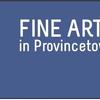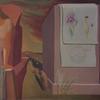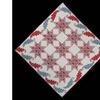Sorry, Anish Kapoor? Artist and MIT Scientists Say They've Created the Blackest Black Ever
- CAMBRIDGE, Massachusetts
- /
- September 16, 2019
Artist Anish Kapoor once made headlines after securing artistic rights to the pigment Vantablack, known as the darkest of all dark shades, for his exclusive use in art. A new material is now said to be 10 times blacker than anything reported before, cutting out over 99.99 percent of light. Made from carbon nanotubes, this groundbreaking "blackest black" seemingly makes things...disappear. In addition, it's available to any artist.
The MIT Center for Art, Science & Technology (CAST) and the New York Stock Exchange (NYSE) are presenting The Redemption of Vanity, created by artist Diemut Strebe in collaboration with MIT scientist Brian Wardle and his lab, at the New York Stock Exchange (by appointment only) now through November 25, 2019.
For the work, a 16.78 carat natural yellow diamond valued at $2 million from L.J.West was coated using a new procedure of generating carbon nanotubes (CNTs), recently measured to be the blackest black ever created, which makes the diamond seem to disappear into an invisible void.
The patented carbon nanotube technology (CNT) absorbs more than over 99.995 percent of incoming light and was developed by Professor Wardle and his lab at MIT.
“Any object covered with this CNT material loses all its plasticity and appears entirely flat, abbreviated/reduced to a black silhouette. In outright contradiction to this we see that a diamond, while made of the very same element (carbon) performs the most intense reflection of light on earth. Because of the extremely high light absorbtive qualities of the CNTs, any object, in this case a large diamond coated with CNT’s, becomes a kind of black hole absent of shadows,“ explains Strebe. “The unification of extreme opposites in one object and the particular aesthetic features of the CNTs caught my imagination for this art project.”
“Strebe’s art-science collaboration caused us to look at the optical properties of our new CNT growth, and we discovered that these particular CNTs are blacker than all other reported materials by an order of magnitude across the visible spectrum”, says Wardle. The MIT team is offering the process for any artist to use. “We do not believe in exclusive ownership of any material or idea for any artwork and have opened our method to any artist,” say Strebe and Wardle.
“The project explores material and immaterial value attached to objects and concepts in reference to luxury, society and to art. We are presenting the literal devaluation of a diamond, which is highly symbolic and of high economic value. It presents a challenge to art market mechanisms on the one hand, while expressing at the same time questions of the value of art in a broader way. In this sense it manifests an inquiry into the significance of the value of objects of art and the art market,” says Strebe. “We are honored to present this work at The New York Stock Exchange, which I believe to be a most fitting location to consider the ideas embedded in The Redemption of Vanity.”
The Redemption of Vanity, conceived by Boston-based conceptual artist Diemut Strebe, has been realized with Brian L. Wardle, Professor of Aeronautics and Astronautics and Director of necstlab and NanoEngineered Composite aerospace STructures (NECST) Consortium and his team Drs. Luiz Acauan and Estelle Cohen, in conjunction with Strebe’s residency at MIT supported by the Center for Art, Science & Technology (CAST).














